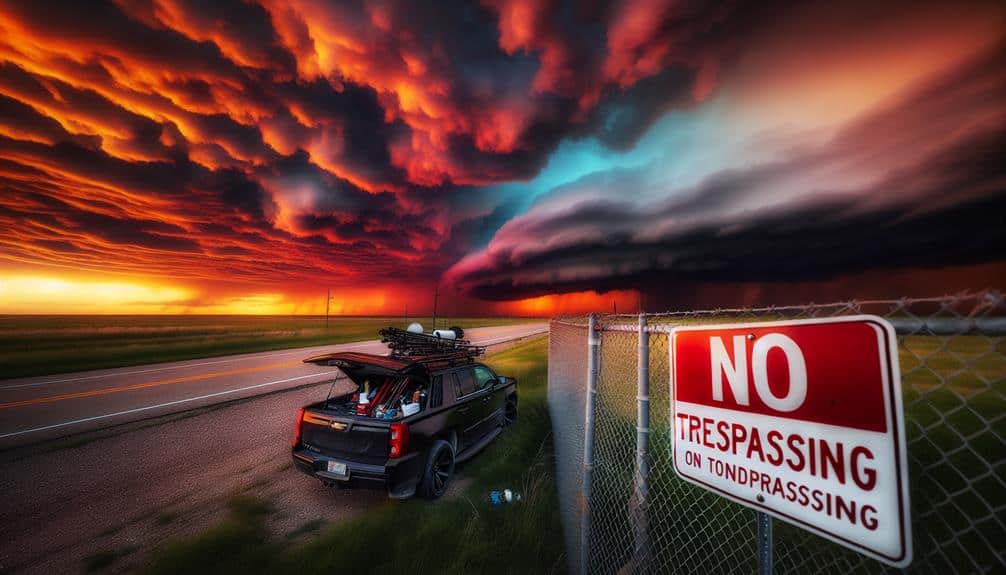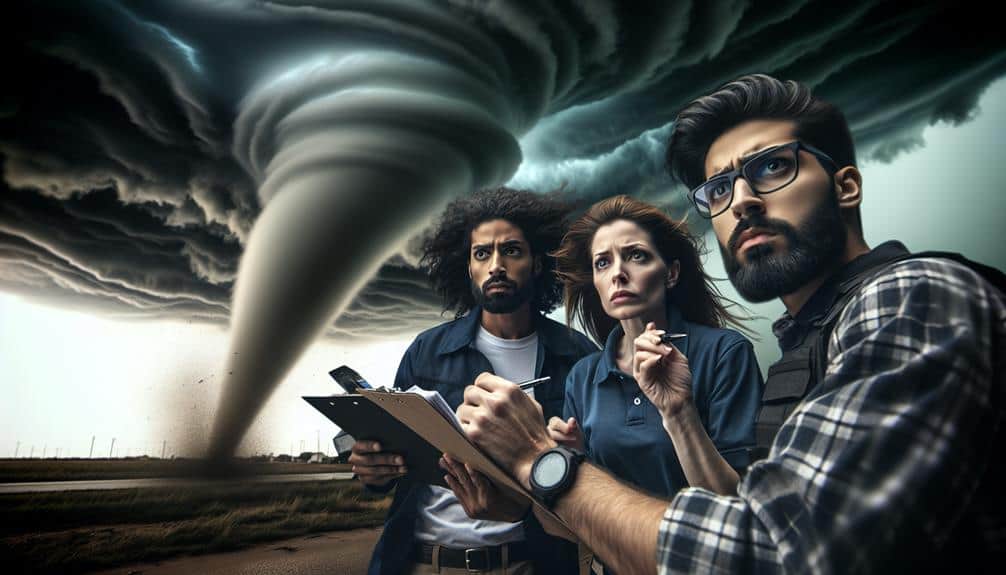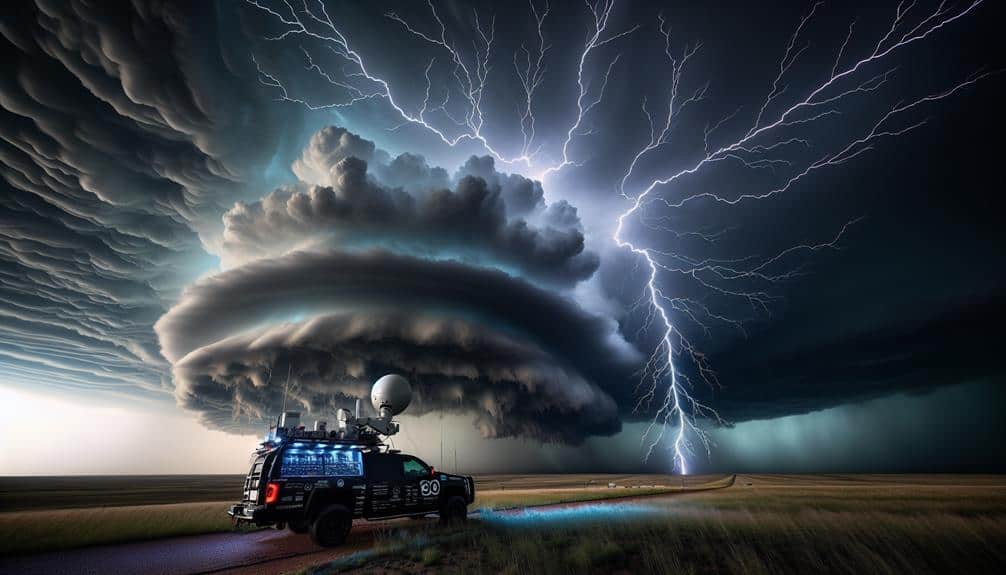As amateur storm chasers, we must respect property boundaries by asking permission before setting up equipment and following local guidelines. Prioritize safety with an emergency kit, reliable communication, and multiple evacuation routes. We should avoid disrupting local communities by sticking to designated roads, respecting traffic laws, and keeping noise levels low. Share data responsibly by guaranteeing accuracy, using standardized formats, and protecting personal information. Compliance with legal regulations, such as obtaining permits and respecting road closures, is essential. By following these five practices, we guarantee safety and uphold the trust of the communities we engage with. Want the full scoop?
Key Points
- Always obtain permission from property owners before setting up any equipment on private land.
- Prioritize safety by preparing a comprehensive emergency kit and planning multiple evacuation routes.
- Respect local communities by adhering to traffic laws and minimizing noise pollution in residential areas.
- Share accurate and anonymized data responsibly to maintain trust and cooperation within the storm-chasing community.
Respect Property Boundaries
As responsible storm chasers, we must always respect property boundaries to guarantee the safety and privacy of local residents. Entering private property without consent not only infringes on individual rights but can also lead to legal ramifications. To avoid such issues, we should always ask permission from property owners before setting up equipment or seeking vantage points. A simple conversation can go a long way in ensuring our presence is both welcomed and lawful.
Moreover, it's essential that we follow guidelines set forth by local authorities and landowners. These guidelines are often in place to protect both us and the property owners. For example, some areas may have specific restrictions due to past storm damage or ongoing recovery efforts. Adhering to these rules not only fosters goodwill but also enhances our safety.
Data from the National Weather Service indicates that 20% of storm-related injuries among chasers occur due to trespassing on unsafe grounds. By respecting property boundaries, we minimize risks and uphold ethical standards.
Let's remain vigilant and respectful, ensuring our passion for storm chasing doesn't come at the cost of others' safety and privacy. This approach benefits everyone involved and maintains the integrity of our community.
Prioritize Safety First
Prioritizing our safety is paramount, and we must always give it top priority above all else when engaging in storm chasing activities. The unpredictable nature of severe weather requires us to be vigilant and well-prepared.
Start by assembling a detailed emergency kit. This should include first aid supplies, water, non-perishable food, a flashlight, extra batteries, a multi-tool, and essential medications. Don't forget a weather radio to receive real-time updates and a portable phone charger to maintain communication.
Effective communication is crucial. We should always inform someone of our plans, including our intended route and estimated return time. Utilize reliable communication devices like two-way radios, especially in areas with poor cell reception. Maintaining a clear line of communication with our team ensures that everyone is informed about changing weather conditions and potential hazards.
Before heading out, we must study weather patterns and forecasts from credible sources like the National Weather Service. This data-driven approach enables us to make informed decisions, reducing risk.
Additionally, having an exit strategy is important. Identify multiple evacuation routes and be ready to abandon the chase if conditions deteriorate rapidly. Prioritizing safety allows us to enjoy the freedom of storm chasing responsibly.
Avoid Disrupting Local Communities
We must minimize our impact on local communities by sticking to designated roads and respecting private property. It's important to remember that our presence can impact the daily lives of residents. By limiting our footprint, we foster positive community engagement and guarantee our passion for storm chasing doesn't inconvenience others.
Here are four key actions to minimize our impact and enhance community engagement:
- Stick to Designated Roads: Straying off into private lands or restricted areas can damage property and disrupt daily activities. Stick to public roads and avoid trespassing.
- Follow Local Traffic Laws: Speeding or erratic driving not only endangers us but also local residents. Adhering to traffic regulations maintains safety and shows respect for the community.
- Reduce Noise Pollution: Loud vehicles and equipment can disturb the peace. Keep noise levels down, especially in residential areas, to avoid causing unnecessary stress to locals.
- Interact with Locals Respectfully: If approached by residents, be courteous and informative. Positive interactions can foster goodwill and support for our storm-chasing activities.
Accurate and timely data sharing is essential for the safety and effectiveness of storm-chasing activities. We must make sure that our data contributions are both reliable and ethically sourced. Ethical data sharing means we don't withhold critical information that could aid weather forecasting and emergency response efforts. By doing so, we reinforce a network of trust and cooperation among storm chasers, meteorologists, and public safety officials.
We should adhere to responsible research practices. This involves double-checking the accuracy of our data before dissemination. Misleading data can result in misguided decisions, endangering lives and property. We must use standardized reporting formats, making certain our data is easily interpretable by others in the field. Real-time updates should be verified and promptly shared with relevant agencies, enhancing the collective situational awareness.
Moreover, we need to respect privacy and confidentiality when sharing data. Personal information of affected individuals or specific locations should be anonymized. Let's aim to contribute constructively to the broader meteorological community. Ethical data sharing and responsible research not only bolster our credibility but also amplify the positive impact of our storm-chasing endeavors, supporting a culture of informed freedom and safety.
Follow Legal Regulations

Adhering to legal regulations is crucial to ensure our storm-chasing activities remain within the bounds of the law and contribute to public safety. When we research local laws and obtain permits, we make sure that our passion for storm chasing doesn't hinder emergency response or put others at risk.
Here are some critical steps to follow:
- Research Local Laws: Each region has specific ordinances related to storm chasing. Familiarize yourself with these laws to avoid fines or legal complications. Not knowing the law isn't an excuse.
- Obtain Permits: Some areas require special permits for storm chasing, especially in high-risk zones. Make sure we secure all necessary permits before embarking on our journey.
- Respect Road Closures: Authorities often close roads during severe weather events to protect public safety. Ignoring these closures could lead to accidents or impede emergency vehicles.
- Coordinate with Local Authorities: Informing local law enforcement or emergency services about our presence can be invaluable. It helps them know who's on the ground and can streamline any potential rescue operations.
Frequently Asked Questions
What Kind of Equipment Is Essential for Amateur Storm Chasing?
Isn't it a coincidence that safety gear and technology often overlap? For storm chasing, we need a reliable camera, GPS tracking, and proper safety gear to guarantee accurate data collection and personal safety in unpredictable conditions.
How Can I Find Accurate Weather Forecasts for Storm Chasing?
To find accurate weather forecasts for storm chasing, we depend on high-quality weather apps and local weather stations. For precise storm prediction and forecast accuracy, we cross-reference multiple data sources to guarantee we stay informed and safe.
What Are the Best Communication Tools for Staying Connected During a Chase?
For staying connected during a chase, we depend on GPS tracking and emergency contacts for safety. Social media keeps us updated in real-time, while weather apps provide precise forecasts. These tools guarantee we're well-informed and connected.
How Can I Join a Local Storm Chasing Group?
Joining a local storm chasing group is like finding the right frequency on a radio. We should leverage local connections and assess group dynamics through social media, forums, or community events to guarantee a compatible and safe experience.
What Resources Can Help Improve My Storm Chasing Skills?
To improve our storm chasing skills, we can utilize online tutorials and training for precise techniques. Additionally, storm spotter guides and specialized books provide accurate data and technical terminology essential for understanding and predicting storm behavior effectively.


